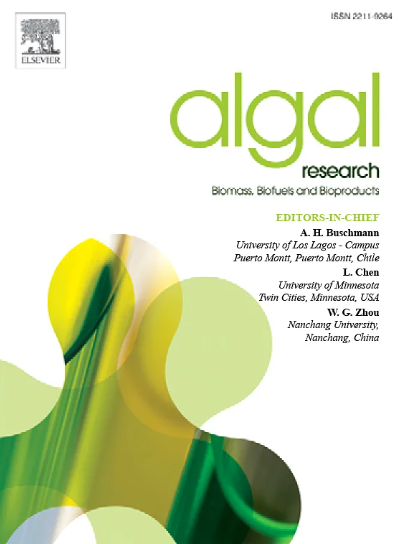A simple growth model of Saccharina latissima cultivated in Scandinavia: Theoretical and practical implications
IF 4.6
2区 生物学
Q1 BIOTECHNOLOGY & APPLIED MICROBIOLOGY
Algal Research-Biomass Biofuels and Bioproducts
Pub Date : 2025-02-18
DOI:10.1016/j.algal.2025.103971
引用次数: 0
Abstract
Our purpose was to construct the simplest possible, biologically-based model that could simulate the biomass growth from autumn to summer of Saccharina latissima cultivated on lines in Scandinavia. We developed the model based on a well-established framework for modelling terrestrial crops, using data from an experiment that we ran for one growing season with S. latissima cultivated on lines in Limfjorden, Denmark. The model was subsequently compared to two independent data sets obtained from previously published studies carried out in Denmark and Norway. Surprisingly, sea temperature was not needed as a driving variable to obtain a model as accurate as earlier models; global irradiation was the only environmental variable necessary to drive the model. Model outputs compared favourably to the independent Norwegian data set, less so to the independent Danish data set. In general, the predicted time trends of S. latissima biomass mimicked both the pattern and the magnitude of the observed biomass. Due to a lack of data, the model did not include the effects of sub-optimal levels of nutrients or salinity; however, thanks to the model's simplicity (it can be formulated in just one line) and its reliance upon basic biological principles, we expect that it can easily be re-calibrated to simulate growth also under sub-optimal conditions. Its plain formulation provides a readily available prediction of the biomass production to be expected from S. latissima cultivation. Moreover, the simplicity of the model makes it straightforward to incorporate as a component in more complex models of marine cropping systems.
求助全文
约1分钟内获得全文
求助全文
来源期刊

Algal Research-Biomass Biofuels and Bioproducts
BIOTECHNOLOGY & APPLIED MICROBIOLOGY-
CiteScore
9.40
自引率
7.80%
发文量
332
期刊介绍:
Algal Research is an international phycology journal covering all areas of emerging technologies in algae biology, biomass production, cultivation, harvesting, extraction, bioproducts, biorefinery, engineering, and econometrics. Algae is defined to include cyanobacteria, microalgae, and protists and symbionts of interest in biotechnology. The journal publishes original research and reviews for the following scope: algal biology, including but not exclusive to: phylogeny, biodiversity, molecular traits, metabolic regulation, and genetic engineering, algal cultivation, e.g. phototrophic systems, heterotrophic systems, and mixotrophic systems, algal harvesting and extraction systems, biotechnology to convert algal biomass and components into biofuels and bioproducts, e.g., nutraceuticals, pharmaceuticals, animal feed, plastics, etc. algal products and their economic assessment
 求助内容:
求助内容: 应助结果提醒方式:
应助结果提醒方式:


